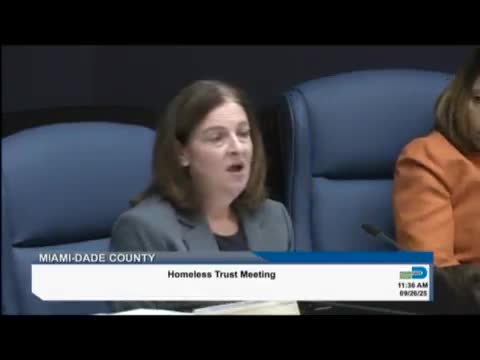Homeless Trust warns HUD cap could force shifts from permanent supportive housing; mobile home park evictions prompt near‑term outreach plans
September 26, 2025 | Miami-Dade County, Florida
This article was created by AI summarizing key points discussed. AI makes mistakes, so for full details and context, please refer to the video of the full meeting. Please report any errors so we can fix them. Report an error »

The Homeless Trust board heard two consequential updates: a potential federal funding change that could force large programmatic shifts and an imminent local displacement scenario that the trust says it will respond to.
Federal funding risk: Staff reported that HUD’s impending Continuum of Care (CoC) Notice of Funding Opportunity (NOFO) could include a cap limiting permanent housing to no more than 30% of a CoC’s portfolio. Staff said the trust’s current HUD portfolio is approximately 84% permanent housing and covers more than 3,100 people in roughly 2,100 households; if a 30% cap is implemented, staff warned the change could force difficult transitional decisions and would likely require scaling transitional or time‑limited rental assistance. Staff and the chair said they have been meeting with congressional delegation members and HUD regional officials and have submitted letters explaining local impacts while asking for transition time to avoid sudden displacements.
Local displacement: Staff reported ongoing court activity at Little Abner mobile home park in Sweetwater, describing it as one of the county’s largest mobile home parks where the owner is selling land for redevelopment. Staff said the sheriff’s office informed the trust that it would be serving 71 writs and asked the trust to provide on‑site services to households who must vacate. Trust staff said they will work with the sheriff’s office to assess needs, offer services and attempt placement assistance for affected residents as they are displaced.
Why it matters: a federal cap on permanent supportive housing could affect thousands of people in the trust’s portfolio and require major reprogramming of HUD grants; the Little Abner eviction action could produce a near‑term increase in households seeking assistance from the trust and partner agencies.
The chair and staff urged continued outreach to congressional offices and the regional HUD director to explain local consequences and to seek flexibility in any transition timeline. Staff said they will maintain communication with county partners and convene on‑site outreach when writs are served.
Federal funding risk: Staff reported that HUD’s impending Continuum of Care (CoC) Notice of Funding Opportunity (NOFO) could include a cap limiting permanent housing to no more than 30% of a CoC’s portfolio. Staff said the trust’s current HUD portfolio is approximately 84% permanent housing and covers more than 3,100 people in roughly 2,100 households; if a 30% cap is implemented, staff warned the change could force difficult transitional decisions and would likely require scaling transitional or time‑limited rental assistance. Staff and the chair said they have been meeting with congressional delegation members and HUD regional officials and have submitted letters explaining local impacts while asking for transition time to avoid sudden displacements.
Local displacement: Staff reported ongoing court activity at Little Abner mobile home park in Sweetwater, describing it as one of the county’s largest mobile home parks where the owner is selling land for redevelopment. Staff said the sheriff’s office informed the trust that it would be serving 71 writs and asked the trust to provide on‑site services to households who must vacate. Trust staff said they will work with the sheriff’s office to assess needs, offer services and attempt placement assistance for affected residents as they are displaced.
Why it matters: a federal cap on permanent supportive housing could affect thousands of people in the trust’s portfolio and require major reprogramming of HUD grants; the Little Abner eviction action could produce a near‑term increase in households seeking assistance from the trust and partner agencies.
The chair and staff urged continued outreach to congressional offices and the regional HUD director to explain local consequences and to seek flexibility in any transition timeline. Staff said they will maintain communication with county partners and convene on‑site outreach when writs are served.
View full meeting
This article is based on a recent meeting—watch the full video and explore the complete transcript for deeper insights into the discussion.
View full meeting